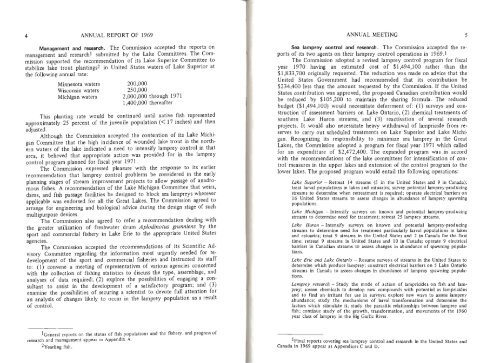Create successful ePaper yourself
Turn your PDF publications into a flip-book with our unique Google optimized e-Paper software.
4 ANNUAL REPORT OF <strong>1969</strong><br />
ANNUAL MEETING<br />
5<br />
Management and research. The <strong>Commission</strong> accepted the reports on<br />
management and research1 submitted by the Lake Committees. The <strong>Commission</strong><br />
supported the recommendation of its Lake Superior Committee to<br />
stabilize lake trout plantings2 in United States waters of Lake Superior at<br />
the following annual rate:<br />
Minnesota waters 200,000<br />
Wisconsin waters 250,000<br />
Michigan waters 2,000,000 tluough 1971<br />
1,400,000 thereafter<br />
This planting rate would be continued until native fish represented<br />
approXimately 25 percent of the juvenile population « 17 inches) and then<br />
adjusted.<br />
Although the <strong>Commission</strong> accepted the contention of its Lake Michigan<br />
Committee that the high incidence of wounded lake trout in the northern<br />
waters of the lake indicated a need to intensify lamprey control in that<br />
area, it believed that appropriate action was provided for in the lamprey<br />
control program planned for fiscal year 1971.<br />
The <strong>Commission</strong> expressed pleasure with the response to its earlier<br />
recommendation that lamprey control problems be considered in the early<br />
planning stages of stream improvement projects to allow passage of anadromous<br />
fishes. A recommendation of the Lake Michigan Committee that weirs,<br />
dams, and fish passage facilities be designed to block sea lampreys wherever<br />
applicable was endorsed for all the <strong>Great</strong> <strong>Lakes</strong>. The <strong>Commission</strong> agreed to<br />
arrange for engineering and biological advice during the design stage of such<br />
multipurpose devices.<br />
The <strong>Commission</strong> also agreed to refer a recommendation dealing with<br />
the greater utilization of freshwater drum Aplodinotus grunniens by the<br />
sport and commercial fishery in Lake Erie to the appropriate United States<br />
agencies.<br />
The <strong>Commission</strong> accepted the recommendations of its Scientific Advisory<br />
Committee regarding the information most urgently needed for redevelopment<br />
of the sport and commercial fisheries and instructed its staff<br />
to: (1) convene a meeting of representatives of various agencies concerned<br />
with the collection of fishing statistics to discuss the type, assemblage, and<br />
analyses of data required; (2) explore the possibilities of engaging a consultant<br />
to assist in the development of a satisfactory program; and (3)<br />
examine the possibilities of securing a scientist to devote full attention for<br />
an analysis of changes likely to occur in the lamprey population as a result<br />
of control.<br />
Sea lamprey control and research. The <strong>Commission</strong> accepted the reports<br />
of its two agents on their lamprey control operations in <strong>1969</strong>.l<br />
The <strong>Commission</strong> adopted a revised lamprey control program for fiscal<br />
year 1970 having an estimated cost of $1,494,100 rather than the<br />
$1,833,700 originally requested. The reduction was made on advice that the<br />
United States Government had recommended that its contribution be<br />
$234,400 less than the amount requested by the <strong>Commission</strong>. If the United<br />
States contribution was approved, the proposed Canadian contribution would<br />
be reduced by $105,200 to maintain the sharing formula. The reduced<br />
budget ($1,494,100) would necessitate deferrment of: (1) surveys and construction<br />
of assessment barriers on Lake Ontario, (2) chemical treatments of<br />
southern Lake Huron streams, and (3) reactivation of several research<br />
projects. It would also necessitate heavy withdrawal of lampricide from reserves<br />
to carry out scheduled treatments on Lake Superior and Lake Michigan.<br />
Recognizing its responsibility to minimize sea lamprey in the <strong>Great</strong><br />
<strong>Lakes</strong>, the <strong>Commission</strong> adopted a program for fiscal year 1971 which called<br />
for an expenditure of $2,472,400. The expanded program was in accord<br />
with the recommendations of the lake committees for intensification of control<br />
measures in the upper lakes and extension of the control program to the<br />
lower lakes. The proposed program would entail the following operations:<br />
Lake Superior - Retreat 14 streams (S in the United States and 9 in Canada);<br />
treat larval populations in lakes and estuaries; survey potential lamprey-producing<br />
streams to determine when retreatment is required; operate electrical barriers on<br />
16 United States streams to assess changes in abundance of lamprey spawning<br />
populations.<br />
Lake Michigan - Intensify surveys on known and potential lamprey-producing<br />
streams to determine need for treatment; retreat 2S lamprey streams.<br />
Lake Huron - Intensify surveys on known and potential lamprey-producing<br />
streams to determine need for treatment particularly larval populations in lakes<br />
and estuaries; treat 9 streams in the United States and 2 in Canada for the first<br />
time; retreat 9 streams in United States and lOin Canada; operate 9 electrical<br />
barriers in Canadian streams to assess changes in abundance of spawning populations.<br />
Lake Erie and Lake Ontario - Resume surveys of streams in the United States to<br />
determine which produce lamprey; construct electrical barriers on S Lake Ontario<br />
streams in Canada to assess changes in abundance of lamprey spawning populations.<br />
Lamprey research - Study the mode of action of lampricides on fish and lamprey;<br />
screen chemicals to develop new compounds with potential as lampricides<br />
and to find an irritant for use in surveys; explore new ways to assess lamprey<br />
abundance; study the mechanisms of larval transformation and determine the<br />
factors which stimulate it; study the parasitic relationships between lamprey and<br />
fish; continue study of the growth, transformation, and movements of the 1960<br />
year class of lamprey in the Big Garlic River.<br />
IGeneral reports on the status of fish populations and the fishery, and progress of<br />
research and management appear in Appendix A.<br />
2Yearling fish.<br />
IFinai reports covering sea lamprey control and research in the United States and<br />
Canada in <strong>1969</strong> appear as Appendices C and D.
















